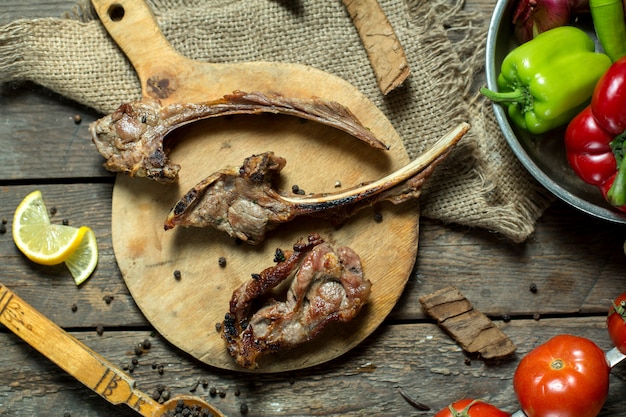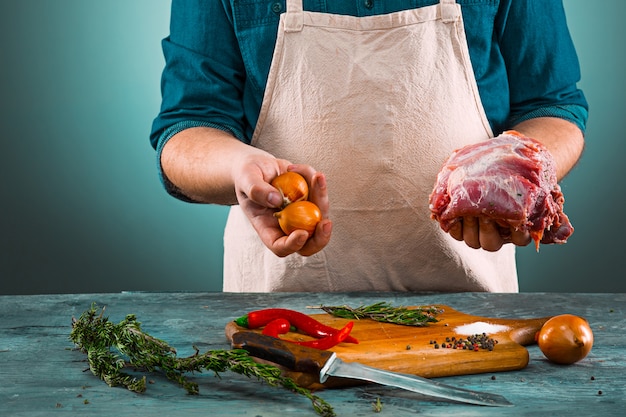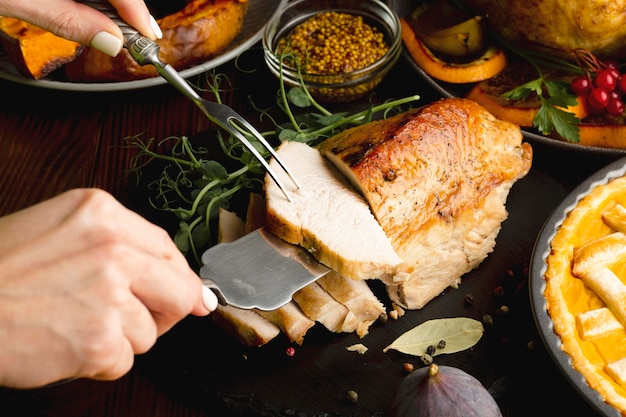Alright, you lot, gather 'round! We're about to delve into the delicious world of deboned leg of lamb. This is a cut of meat that's practically begging to be the star of a special occasion, a Sunday roast, or even just a fancy weeknight dinner. It's unbelievably versatile, cooks up beautifully, and packs a punch of flavour that'll have your taste buds doing a happy dance. Plus, once you get the hang of it, it's really not as scary as it might seem. I've been wrestling with lamb for years, and I'm happy to share all my tried-and-tested tips and tricks. So, grab a cuppa, sit back, and let's get started.
(Part 1) Choosing the perfect lamb

First things first, you need to pick the right lamb. And trust me, choosing the right cut is crucial for a successful roast. I've made the mistake of grabbing a less-than-ideal leg, and let me tell you, it's not a pretty sight. So, what should you be looking for?
The Cut
A deboned leg of lamb is the gold standard for a roast. It's a generous cut, usually weighing in between 2.5 and 3.5 kg, making it perfect for feeding a crowd. You can find it with or without the fat cap, which is a layer of fat that sits on top of the meat. I always recommend getting one with the fat cap - it adds a whole load of flavour and keeps the meat moist. Think of it as a flavour bomb that melts down during cooking, adding richness and a depth of taste that's simply divine.
The Quality
Now, let's talk about quality. You'll usually find lamb labelled as "grass-fed," "free-range," or "organic." If you can swing it, go for "grass-fed" or "free-range" lamb - it's got a more intense flavour that really sings. "Organic" is a good option too, but it's not always necessary for a delicious roast.
You want to look for lamb with a good colour - a nice, deep red, without any strange discoloration. And don't be afraid to ask your butcher for advice. They're the experts, and they can help you find the perfect cut for your needs.
(Part 2) Preparing Your Lamb for Glory

You've got your lamb, now it's time to get it prepped for the oven. Don't worry, it's not as complicated as it sounds. It's all about a bit of prep and some flavour-boosting tricks.
Trimming the Fat
First things first, you'll want to trim away any excess fat. You don't need to remove it all, just get rid of any large, thick bits. A bit of fat is good for flavour, but too much can make the meat greasy and leave you feeling a bit guilty. You can use a sharp knife or kitchen shears for this step - whatever makes you feel comfortable.
Seasoning Your Lamb to Perfection
Now, let's talk seasoning - this is where the real magic happens! I love using a simple mix of salt, pepper, and rosemary, but the possibilities are endless! You can experiment with garlic, paprika, cumin, or even a pinch of chili flakes. Just remember to season liberally - you want the flavour to penetrate right through the meat.
Here are a few seasoning ideas to get your creative juices flowing:
- Classic Herb Blend: This simple mix of rosemary, thyme, oregano, and garlic is a classic for a reason. It adds a warm, earthy flavour to the lamb that's simply irresistible.
- Mediterranean Spice Rub: This combination of cumin, paprika, turmeric, oregano, garlic, and lemon zest gives the lamb a bright, citrusy flavour with a touch of warmth. It's perfect for pairing with vegetables like tomatoes and zucchini.
- Lemon and Garlic: For a simple and flavourful seasoning, just rub the lamb with a mixture of lemon zest and minced garlic. It's a refreshing and vibrant flavour combination that goes well with almost any side dish.
- Garlic and Herbs: Minced garlic, rosemary, thyme, and a pinch of red pepper flakes create a flavour profile that's both aromatic and savory.
- French Herbes de Provence: A mix of dried herbs including thyme, rosemary, marjoram, oregano, and basil, Herbes de Provence adds a fragrant touch of Proven??al charm to your lamb.
(Part 3) Roasting Your Lamb to Perfection

Alright, now we're getting to the good stuff - the roasting! Don't let this part intimidate you. It's actually quite simple, and the result is a beautifully cooked, juicy leg of lamb that'll have everyone singing your praises.
Choosing the Right Temperature
The temperature you roast your lamb at is important. For a medium-rare finish (my personal favourite), you want to cook it at 180°C (350°F) for about 20 minutes per 500g (1lb).
cooking times
Now, let's talk cooking times. A 2.5kg (5.5lb) deboned leg of lamb will take around 1 hour and 40 minutes to cook. Remember, cooking times can vary depending on the size and thickness of your lamb, so always check the internal temperature with a meat thermometer to make sure it's cooked to your liking.
Resting Your Lamb - The Secret to Juiciness
Once your lamb is cooked, it's crucial to let it rest for at least 15 minutes before carving. This gives the juices a chance to redistribute, resulting in a more tender and flavourful piece of meat. Cover it loosely with foil and let it rest in a warm place. While you wait, you can prep your sides or maybe even pour yourself a glass of wine to celebrate your culinary masterpiece.
(Part 4) Accompanying Sides - The Perfect Partners for Your Lamb
No roast lamb is complete without a selection of delicious sides. The possibilities are endless, but here are a few of my personal favourites:
Roasted Vegetables - A Classic Side
Roasted vegetables are a classic accompaniment to roast lamb. They're simple to make, incredibly versatile, and offer a range of colours and textures to complement the lamb. I love roasting root vegetables like carrots, potatoes, and parsnips, along with seasonal vegetables like asparagus, broccoli, or zucchini.
Here's a simple roasted vegetable recipe that never fails to impress:
- Preheat your oven to 200°C (400°F).
- Cut your vegetables into bite-sized pieces.
- Toss them in olive oil, salt, pepper, and any herbs or spices you like.
- Spread them in a single layer on a baking sheet and roast for 20-30 minutes, or until tender and slightly caramelized.
Green Salad - A Refreshing Contrast
A fresh green salad is a perfect way to balance out the richness of the roast lamb. Use any combination of your favourite greens, like lettuce, spinach, or kale. Add some chopped vegetables, herbs, nuts, and a light dressing for extra flavour.
Gravy - The Finishing Touch
Gravy is a must-have for any roast lamb. It's a rich and flavourful sauce that enhances the taste of the meat. You can make a simple gravy from the pan juices, or you can get more elaborate with a stock-based gravy.
Here's a simple recipe that's perfect for a busy weeknight:
- After you've removed the lamb from the roasting pan, pour off any excess fat.
- Add a tablespoon or two of flour to the pan and cook it over medium heat for a few minutes, stirring constantly, to make a roux.
- Gradually whisk in some lamb stock or water until the desired consistency is achieved.
- Bring the gravy to a simmer and cook for a few minutes, until thickened. Season to taste with salt, pepper, and any herbs or spices you like.
(Part 5) Serving and Enjoying Your Culinary Masterpiece
The moment has finally arrived - it's time to serve your masterpiece! This is the part where all your hard work pays off. Here are a few tips for serving your lamb with style:
Carving Your Lamb - It's Easier Than You Think
Carving a deboned leg of lamb is surprisingly easy, even if you're not a seasoned chef. Just slice it against the grain, into thin, even pieces. It's always a good idea to serve the lamb on a platter, surrounded by its delicious sides. Let your guests choose the pieces they want and enjoy!
Presentation - Make it Look as Good as It Tastes
Presentation is key! A beautifully presented roast lamb is a real showstopper. I like to arrange the carved lamb on a platter, surrounded by a mix of roasted vegetables. You can also add a few sprigs of rosemary or thyme for a touch of colour. Don't forget the gravy! Pour it over the lamb and serve it alongside the sides.
Wine Pairings - Elevate the Experience
To complete the experience, choose a wine that complements the flavours of the lamb. A full-bodied red wine, like Cabernet Sauvignon or Merlot, is a classic pairing. However, you could also opt for a lighter red, like Pinot Noir, or even a crisp white wine, like Sauvignon Blanc.
(Part 6) Storing Leftovers - Enjoy the Deliciousness Again
Let's be honest, you're probably going to have leftovers. And that's a good thing! Roast lamb is even more delicious the next day. To store leftovers, wrap them tightly in plastic wrap or foil and refrigerate for up to 3 days. You can reheat the lamb in the oven or microwave.
(Part 7) Mastering Different Cooking Methods - Beyond the Roast
Roast lamb isn't the only way to enjoy this delicious cut of meat! Here are a few other methods that you can try:
Slow-Cooked Lamb - Tenderness Beyond Compare
slow cooking lamb is a fantastic option for achieving ultra-tender results. It's perfect for a busy weeknight when you don't have a lot of time. You can cook it in a slow cooker or dutch oven, with vegetables and a flavorful broth. The long, slow cooking process breaks down the tough muscle fibers, making the lamb incredibly tender and juicy.
grilled lamb - The Smoky Charm
Grilling lamb is another great way to add a smoky flavour. For best results, use a good quality, bone-in leg of lamb. Marinate it for a few hours in a mixture of olive oil, lemon juice, garlic, and herbs. Grill it over medium heat for 15-20 minutes per side, or until cooked to your liking.
Pan-Seared Lamb - Quick and Delicious
For a quick and delicious meal, try pan-searing your lamb. This method creates a beautiful crust on the outside while keeping the inside juicy and tender. Season your lamb generously and sear it in a hot pan with a bit of olive oil.
(Part 8) Experimenting with Different Flavors - A World of Taste
Once you've mastered the basics, it's time to start experimenting with different flavours and spices. Here are a few ideas to get you started:
Middle Eastern Inspired - A Blend of Sweet and Savory
Add a Middle Eastern touch with a blend of spices like cumin, coriander, turmeric, and paprika. You can also incorporate ingredients like dried apricots, dates, and almonds for a sweet and savory flavour combination.
Italian-Style - The Classics With a Twist
Bring the flavours of Italy to your lamb with a blend of rosemary, garlic, and lemon. You can also add a splash of white wine or red wine vinegar to the pan juices for added depth of flavour.
Asian Inspired - Bold and Aromatic
For an Asian-inspired twist, try marinating your lamb in a mixture of soy sauce, ginger, garlic, and sesame oil. You can also add a touch of honey or brown sugar for sweetness.
North African-Style - Flavorful and Exotic
Embrace the vibrant flavours of North Africa with a spice blend that includes cumin, coriander, turmeric, paprika, cinnamon, and cloves. You can also add a touch of harissa paste for a kick of heat.
Indian-Inspired - A Symphony of Spices
Transport your taste buds to India with a blend of aromatic spices like turmeric, cumin, coriander, garam masala, ginger, and garlic. You can also add a touch of yogurt or cream for a creamy and rich flavour.
FAQs - Your Burning Questions Answered
What's the best way to cook a deboned leg of lamb?
The best way to cook a deboned leg of lamb is by roasting it in the oven. Roasting allows the meat to cook evenly and develops a beautiful crust. You can also slow-cook it, grill it, or pan-fry it, but roasting is the most common and reliable method for achieving juicy and flavorful results.
How long does it take to cook a deboned leg of lamb?
The cooking time for a deboned leg of lamb depends on the size of the cut and the desired level of doneness. As a general rule, a 2.5kg (5.5lb) leg of lamb will take about 1 hour and 40 minutes to cook at 180°C (350°F). Always check the internal temperature of the meat with a meat thermometer to ensure it's cooked to your liking.
What temperature should lamb be cooked to?
The recommended internal temperature for lamb is 63°C (145°F) for medium-rare, 71°C (160°F) for medium, and 77°C (170°F) for medium-well. Always use a meat thermometer to check the internal temperature of the lamb, as this is the most accurate way to ensure it's cooked to your preference.
What are some good side dishes to serve with roast lamb?
Roast lamb pairs well with a variety of side dishes, including roasted vegetables, mashed potatoes, green salads, and gravy. You can also try more adventurous options, like couscous, quinoa, or a lentil salad.
What can I do with leftover roast lamb?
Leftover roast lamb can be used in a variety of ways. You can make lamb sandwiches, salads, or pasta dishes. It also freezes well for up to 3 months, so you can enjoy the deliciousness again later.
There you have it! You're now armed with the knowledge to tackle any deboned leg of lamb that comes your way. Remember, practice makes perfect, and don't be afraid to experiment with different flavours and cooking methods. Get creative, have fun, and most importantly, enjoy!
Everyone is watching

Corn on the Cob: The Ultimate Guide to Perfectly Cooked Ears
Healthy MealsAh, corn on the cob. Just the name evokes images of sunny days, barbecues, and that sweet, juicy flavour that ...

Perfect Pork Roast Oven Cooking Time: A Guide to Delicious Results
Healthy MealsThere's something truly satisfying about a perfectly roasted pork. The aroma alone is enough to make your mout...

Scallops: The Ultimate Guide to Perfect Cooking
Healthy MealsAh, scallops. Those delicate, sweet, and utterly delicious morsels of the sea. They hold a special place in my...

Ham Cooking Time: How Long to Bake, Smoke, or Boil a Delicious Ham
Healthy MealsAh, ham. It's a classic, isn't it? A real crowd-pleaser, especially around holidays. And when done right, it'...

Spaghetti Squash: The Ultimate Guide to Cooking and Serving
Healthy MealsRemember that time you saw spaghetti squash at the supermarket, looking all bumpy and strange, and thought, "W...
